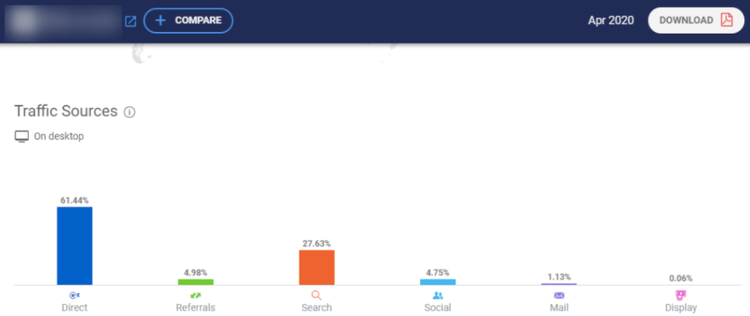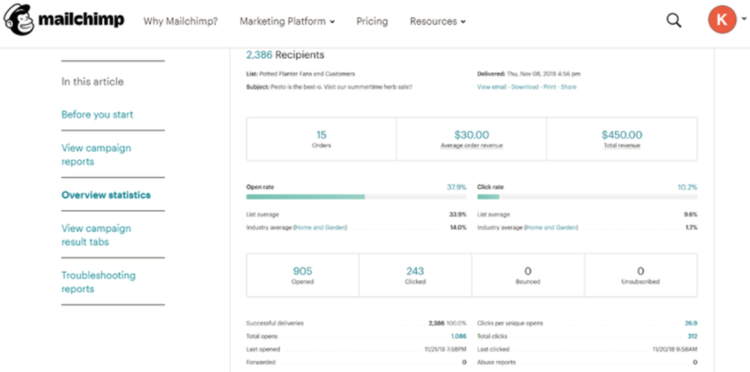Measuring, tracking, and analyzing your marketing data gives you actionable insights to evaluate your campaigns and improve their effectiveness.
But don’t spend all your time and energy analyzing every metric and key performance indicator (KPI) you can get your hands on because they’re not all relevant.
Focus on critical marketing analytics that gives a comprehensive view of your small business to assess where and how your campaigns are succeeding -- which will help you further refine and develop your marketing plan.
Overview: What is digital marketing analytics?
Digital marketing analytics analyzes and evaluates the performance of your marketing initiatives to gain insights for better decision-making.
Marketing data analytics tools gather data from multiple channels to understand your consumers’ behavior better, improve your strategies, and avoid wasting your marketing resources.
Before mapping out your marketing analytics process, understand the difference between marketing and advertising so you can build your framework with clarity.
Advertising is specific to communicating your brand. Marketing is a wider-reaching and more controlled process -- from research to performance tracking.
6 digital marketing analytics your small business should pay attention to
It’s tempting to track every marketing metric to ensure the effectiveness and sustainability of your strategies and market your website, but not all of them are worth focusing on.
Focus on these six important digital marketing analytics to make better business decisions.
1. Traffic source
Knowing which channels and campaigns your visitors are responding to helps you optimize your marketing spend.
It tells you which platforms are bringing traffic to your business website, enabling you to invest more on traffic sources that bring meaningful results, and abandoning those that aren’t performing.
SimilarWeb, for instance, will show your main website traffic sources:
- Direct visitors - Users who entered your URL into the search bar directly or bookmarked your site and returned.
- Social - Traffic from visitors who land on your website after coming from your content posts or social media profile.
- Organic search - Users who clicked on a search engine result link to your website.
- Referrals - Visitors directed to your website when they clicked on a link from another site.

These are the traffic sources of the sample website we analyzed in Similarweb. Image source: Author
2. Pageviews
This metric measures the number of times users load your web pages and which pages attract the most attention.
Although this metric is broad, it is vital when planning your content creation and search engine optimization (SEO) efforts.
Place your call-to-action, clickable links, and other content on your pages that get tons of views to increase your conversion and sales opportunities.
If your pages aren’t getting that many views, double down on marketing efforts such as engagement marketing or other inbound marketing strategies to bring more traffic to your website.
3. Average session duration
Several factors affect the average time users spend on your website. Studying this metric helps you learn about your site’s performance in terms of user experience.
The better the user’s experience, the longer they will stay on your site, and the more likely they are to return.
Your average session duration tells you important information: if your website is easy to navigate, if users find what they are looking for in the least amount of time, and if your content is worth viewing at length.
4. Bounce rate
Bounce rate indicates the percentage of people who click away after viewing only one page on your website. It’s a great indicator of the effectiveness of your content, strategies, and campaigns.
For example, If you’re marketing a new product, users expect to see it when they click your ad, perhaps ending up on an informative landing page. If you direct them to your homepage instead, it could confuse your visitors and cause them to click away.
Knowing this would prompt you to change the URL on your ad so your users are sent directly to your product page.
5. Exit rate
Unlike the bounce rate, the exit rate shows the percentage of exits from a specific page.
Tracking this metric throughout your website helps you understand why visitors are losing interest and leaving. This leads you to study and improve webpage content on the pages with the most exits.
6. Conversion rate
Essentially, your conversion rate is the percentage of website visitors who act on your conversion goals, such as making a purchase or subscribing to your newsletter.
Use online marketing analytics to track your conversions and determine which marketing efforts are succeeding and which are underperforming.
This metric also helps you evaluate which parts of your integrated marketing strategies are leaking leads and potential sales.
How to use digital marketing analytics to improve your small business marketing
Put your marketing analytics into action and improve your small business marketing by following the four methods below.
Method #1: Monitoring campaign performance
Tracking the performance of your campaigns is digital marketing 101 because you can’t run assessments without tracking.
Work with analytics tools that provide real-time monitoring features. With them, you can refine your strategies more efficiently and maximize ad spend.
Social media management platforms, such as Buffer, have analytics functions to help you track key metrics including followers, engagement rate, and social campaign reach.

This dashboard overview reveals your social media campaign metrics. Image source: Author
Tracking your campaigns help you plan your next steps and make data-driven marketing decisions.
Method #2: Understanding customer behavior
Acquiring customers requires understanding and predicting consumer behavior patterns so you can assess their responsiveness and tailor your campaigns to answer their needs.
Use marketing automation tools, such as Mailchimp, to engage your prospects, nurture them, and track their responses to your campaigns.

Marketing statistics from Mailchimp will help you understand your campaign ROI. Image source: Author
Through the platform’s email marketing analytics feature, uncover the subscribers who engaged with your email newsletter, the social media shares and likes of your campaign, your email marketing campaign performance within the first 24 hours, and more.
Marketing automation platforms help you understand customer behavior -- allowing you to create campaigns that get better engagement and, ultimately, increase your sales and profits.
Method #3: Forecasting demand
Timely data helps power marketing analytics, which makes logging historical information vital to identifying trends and anticipating demand.
Several factors, such as seasonality, can affect demand for your products and services. This also affects the effectiveness of your marketing campaigns.
Digital analytics will help you uncover these variables so you can plan your marketing strategies.
Forecasting models via predictive analytics help you understand which products are likely to get high demand next quarter or how campaign changes will affect their performance.
Method #4: Building strategies around data insights
Create your marketing strategies based on data and use it to lead your planning and decision-making. Doing so increases your marketing campaign’s success.
Try these steps to help you build data-based marketing strategies:
- Approach data from different angles. You can interpret data many ways, and each provides different, valuable insights. Don’t limit your view, you could miss key perspectives.
- Test regularly. Digital marketing for a small business is dynamic. Constantly testing your strategies will help you uncover new methods that can lead to improved conversions and sales.
Find the metrics that matter most for your small business
Focusing on important metrics allows you to extract actionable insights to improve your marketing strategies.
With the right metrics, you get a clearer picture of your marketing campaign’s health, allowing you to make necessary adjustments where needed. Keep tracking and analyzing to experience consistent growth.
Our Small Business Expert
We're firm believers in the Golden Rule, which is why editorial opinions are ours alone and have not been previously reviewed, approved, or endorsed by included advertisers. The Ascent does not cover all offers on the market. Editorial content from The Ascent is separate from The Motley Fool editorial content and is created by a different analyst team.